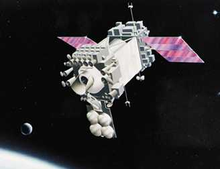- Midcourse Space Experiment
-
The Midcourse Space Experiment (MSX) is a Ballistic Missile Defense Organization satellite experiment (unmanned space mission) to map bright infrared sources in space. MSX offered the first system demonstration of technology in space to identify and track ballistic missiles during their midcourse flight phase.[1]
Contents
History
On 24 April 1996, the BMDO launched the MSX satellite on a Delta II booster from Vandenberg AFB, California. MSX was placed in a sun-synchronous orbit at 898 km and an inclination of 99.16 degrees. MSX's mission was to gather data in three spectral bands (long wavelength infrared, visible, and ultraviolet). MSX became a contributing sensor to the Space Surveillance Network on 13 May 1998.
Operations
Operational from 1996–1997, MSX mapped the galactic plane and areas either missed or identified as particularly bright by the Infrared Astronomical Satellite (IRAS) at wavelengths of 4.29 µm, 4.35 µm, 8.28 µm, 12.13 µm, 14.65 µm, and 21.3 µm. It carried the 33-cm SPIRIT III infrared telescope with solid hydrogen-cooled five line-scanned infrared focal plane arrays.
Calibration of MSX posed a challenge for designers of the experiment, as baselines did not exist for the bands it would be observing under. Engineers solved the problem by having MSX fire projectiles of known composition in front of the detector, and calibrating the instruments to the known black-body curves of the objects. The MSX calibration serves as the basis for other satellites working in the same wavelength range, currently including AKARI and the Spitzer Space Telescope.
MSX data is currently available in the Infrared Science Archive (IRSA) provided by NASA's Infrared Processing and Analysis Center (IPAC).
References
- ^ Williams, Frank. "Space-Based Surveillance Operations Advanced Concept Technology Demonstration," Space Tactics Bulletin, Vol 6, Issue 4
External links
- The Midcourse Space Experiment Point Source Catalog Version 2.3 Explanatory Guide From VizieR Catalogue Service
- The Spatial Infrared Imaging Telescope III
Space observatories Current Planned Nano-JASMINE · Astrosat (2012) · NuSTAR (2012) · Hard X-ray Modulation Telescope (HXMT) (2012) · GAIA (2013) · Spectrum-X-Gamma (2013) · Astro-G (2013+) · James Webb Space Telescope (JWST)
Proposals ATHENA · ATLAST · EChO · Euclid · LOFT · Fresnel Imager · New Worlds Mission · NGO · PLATO · SPICA · THEIA · WFIRST
Completed Akari (Astro-F) (2006-2011) · ALEXIS (1993-2005) · ASCA (Astro-D) (1993-2000) · Astro-1 (BBXRT · HUT) (1990) · Astro-2 (HUT) (1995) · Astron (1983-1989) · Astronomical Netherlands Satellite (1974-1976) · ATM (1973-1974) · BeppoSAX (1996-2003) · CHIPSat (2003-2008) · Compton Gamma Ray Observatory (1991-2000) · Cos-B (1975-1982) · COBE (1989-1993) · EPOCh (2008) · EXOSAT (1983-1986) · EUVE (1992-2001) · FUSE (1999-2007) · Ginga (1987-1991) · Granat (1989-1998) · Hakucho (1979-1985) · HALCA (1997-2005) · HEAO-1 (1977-1979) · HEAO-2 (Einstein Observatory) (1978-1982) · HEAO-3 (1979-1981) · HETE-2 (2000-2007?) · Hipparcos (1989-1993) · International Ultraviolet Explorer (1978-1996) · IRAS (1983) · ISO (1996-1998) · LEGRI (1997-2002) · MSX (1996-1997) · OAO-2 (1968-1973) · OAO-3 (Copernicus) (1972-1981) · Orion 1/2 (1971/1973) · RELIKT-1 (1983-1984) · ROSAT (1990-1999) · SAS-B (1972-1973) · SAS-C (1975-1979) · Tenma (1983-1985) · Uhuru (1970-1973) · WMAP (2001-2010) · Yohkoh (1991-2001)
Lost Completed On hiatus TAUVEX (2011)
Old plans Constellation-X · Darwin · Destiny · Eddington · FAME · IXO · JDEM · LISA · SIM & SIMlite · SNAP · TESS · TPF · XEUS
See also Great Observatories program · List of space telescopes · Sun spacecraft
 Category
Category← 1995 · Orbital launches in 1996 · 1997 → STS-72 (SPARTAN-206) | PAS-3R · MEASAT-1 | Koreasat 2 | Kosmos 2327 | Gorizont #43L | Palapa C1 | N-Star B | Intelsat 708 | NEAR Shoemaker | Kosmos 2328 · Kosmos 2329 · Kosmos 2330 · Gonets-D1 #1 · Gonets-D1 #2 · Gonets-D1 #3 | Gran' #44L | Soyuz TM-23 | STS-75 (TSS-1R) | Polar | REX II | Intelsat 707 | Kosmos 2331 | IRS-P3 | STS-76 | USA-117 | Inmarsat-3 F1 | Astra 1F | MSAT-1 | Priroda | MSX | Kosmos 2332 | USA-118 | BeppoSAX | Progress M-31 | USA-119 · USA-120 · USA-121 · USA-122 · USA-123 · USA-124 | Kometa #18 | Palapa C2 · Amos-1 | MSTI-3 | STS-77 (SPARTAN-207 · IAE · PAMS-STU) | Galaxy 9 | Gorizont #44L | Cluster F1 · Cluster F2 · Cluster F3 · Cluster F4 | Intelsat 709 | STS-78 | Kobal't | TOMS-EP | USA-125 | Apstar 1A | Arabsat 2A · Turksat 1C | USA-126 | USA-127 | Progress M-32 | Télécom 2D · Italsat 2 | Molniya 1-79 | Midori · Fuji 2 | Soyuz TM-24 | Chinasat-7 | FAST | Interbol 2 · Maigon 5 · Victor | Kosmos 2333 | Kosmos 2334 · UNAMSAT-2 | Inmarsat-3 F2 | GE-1 | EchoStar II | USA-128 | STS-79 | Ekspress-6 | FSW-17 | Molniya 3-62 | HETE · SAC-B | Mars Global Surveyor | Arabsat 2B · MEASAT-2 | Mars 96 | STS-80 (WSF · ORFEUS-SPAS) | Progress M-33 | Hot Bird 2 | Mars Pathfinder (Sojourner) | Kosmos 2335 | Inmarsat-3 F3 | Kosmos 2336 | USA-129 | Bion #11Payloads are separated by bullets ( · ), launches by pipes ( | ). Manned flights are indicated in bold text. Uncatalogued launch failures are listed in italics. Payloads deployed from other spacecraft are denoted in brackets. Categories:- Space telescopes
- Infrared telescopes
- 1996 in spaceflight
- Spacecraft launched by Delta II rockets
- Astronomy stubs
Wikimedia Foundation. 2010.

